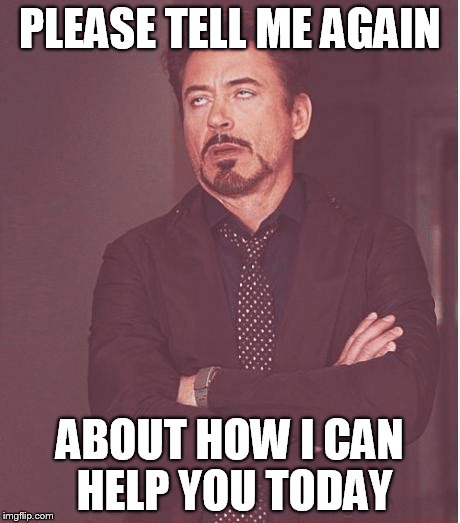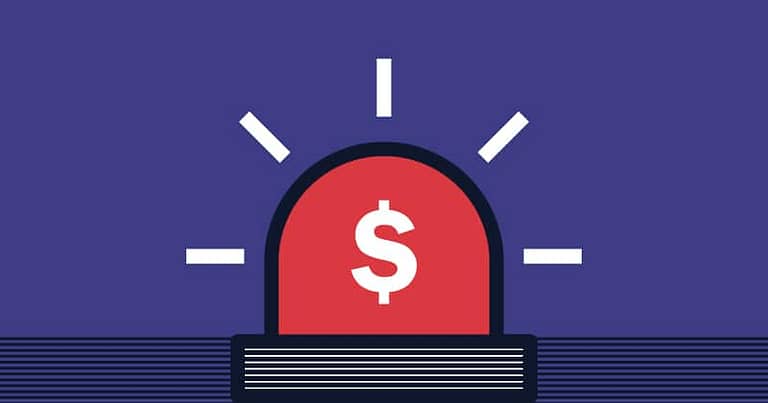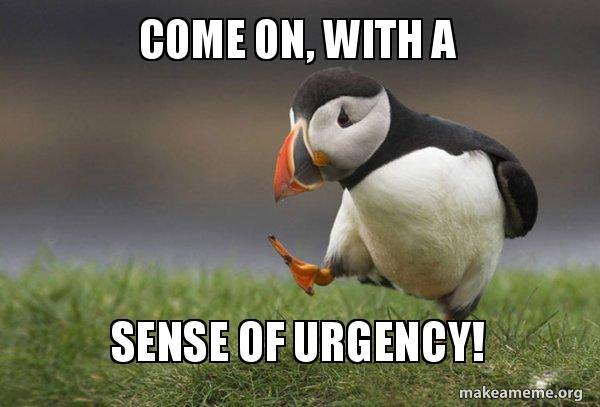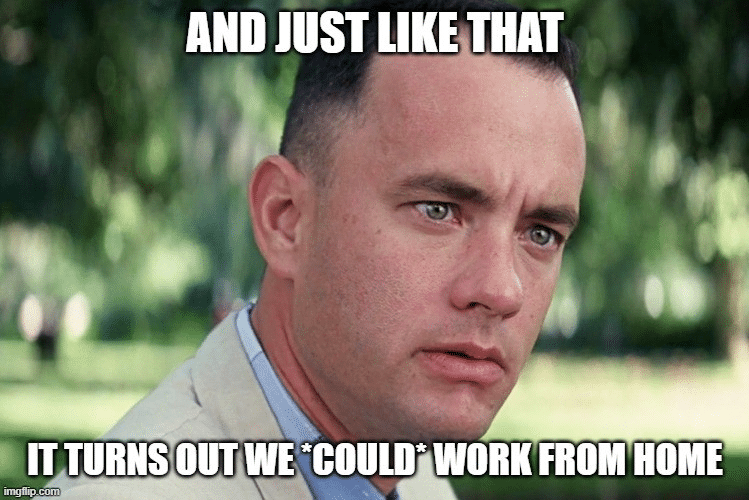On the Importance of Maintaining a Strong Sense of Urgency, and When to Relax it
And the Peakdecline curve of WFH
One of the critical things a startup has vs. the more established incumbents is a sense of urgency.
You cannot fake it. It is also not easy to define. It manifests itself in diverse ways throughout the various stages of a startup’s life.
It is, however, evident when it does not exist.
At the stages that I invest in (pre-seed to A), a sense of urgency mostly means a timely reaction to the market feedback loop, such as understanding quickly if a product feature is required (or not). How can this product feature be made even more useful to an even wider part of your market if it is needed?
All stakeholders in the startup at this stage are within 1-degree of separation. Decision making based on this fast and direct market feedback, and executing according to those decisions can and should be super-fast.
I am not talking about major strategic shifts (aka ‘pivots’). I am talking about your product’s natural gradual evolution based on the market interacting with it.
Sam Altman said that in his experience, the leading indicator for winners is the start-up that cranks out more functionality, more often. In general, that is a first-degree proxy to the “machine is working well,” encompassing all vital organs of a startup working in unison.
The proxy may become quarterly revenue predictability, quarterly revenue growth trajectory, and churn management at later stages of your startup’s life.
Every stage in a startup’s life has its top direct proxy that encompasses the “machine is overall, working fine.” I say “overall” on purpose, as no startup is perfect. In fact, for most startups, it is an exercise in continually shifting chaos from one part of the organization to another, while trying to create success.
While it is a topic for a separate post, there is something I heard Ben Horowitz say that amused me because it was so right. He noted that most VCs’ path to becoming VCs was not through work at a startup. Instead, most had a stellar career elsewhere where they were typically at the top of their class, the top of their investment bank, etc. — very much used to a sense of order and control over their past success. When they face their first startup as investors, they are often stunned by the mess they find :).
The flip side of the sense of urgency is that at times, parts of your startup might keep functioning like a very well-oiled machine, ignoring issues at other ends of the process.
A case at hand: during COVID-19, many startups lost their direct market feedback. Their crucial contact points within potential SMBs and Enterprise clients all sheltered away. However, their engineering teams kept cranking code and adding functionality without closing the loop. They kept working with a sense of urgency, albeit not necessarily on the right thing. That calls for creative ways of finding alternative sources of truth on product progress.
Hopefully, this is a rare exception as we do not expect multiple pandemics hitting us every year now, do we?
An excellent engineering team, working with a sense of urgency and fast market feedback loops, should not be measured only by the amount of code they write or features they release. The amount of code they delete and features they remove can be as substantial an indication of the machine working well, and all parts communicating well on what is working and what is not working in terms of the markets’ feedback to their product. Being negatively dogmatic in startup terminology is, for example, never removing a feature you developed (nor deleting code) for fear of losing sunk cost and optimism bias that someday someone will use it. Wrong.
Speaking about a sense of urgency, you should know that it is elementary for an experienced VC, a good founder, or anyone with enough startup experience to spot its existence or absence very quickly. Is the feedback loop with the market well working? The smell of stagnation in a rotten CI/CD process is hard to miss. Nor are slow-release cycles, slow decision cycles, sluggish digestion, and reaction to direct market feedback on high priority needs.
I worry most from what I call the perfect-product-manager syndrome. That is demonstrated by a PM who knows “best” what the market needs. Such a PM insists every feature must be built to perfection before being released and tested by the market.
Yes, that was Steve Jobs. And he very often got it right. Like Henry Ford before him, Steve Jobs so often knew what the market needed earlier and better than the market itself could imagine.
Assuming you are not lucky enough to have the second coming of Steve Jobs running your product management team, releasing “perfect” features “late” is a sure recipe for disaster.
The much better version is a product manager who is scared silly — someone who admits to their gaps in knowledge and feels at times clueless. Someone who has no self-illusions about understanding it all. Therefore, they are looking for faster, smaller releases to learn how the market reacts and what the market needs and uses, and feed this information back for a quick cycle. It’s a known idiom — if you’re not embarrassed with the feature you’ve just released, you’ve waited too long. I must add my caveat to this known idiom: correct, without compromising on quality. Less functionality is always okay. Poor customer experience due to low quality never is.
Now to COVID-19 and WFH.
It is nearly September 2020 while I write this. COVID-19 hit China around January and most of the western world by March 2020. In the first few months of the pandemic, everyone, myself included, reported being way more productive. Productive in the sense of staying long hours in front of our laptops at home, taking fewer breaks, and cranking more code. In my case, as a VC, this meant holding more Zoom calls with potential new investments and with current portfolio companies (when they felt like it).
This social experiment of WFH shaved hours off our daily commute and eliminated office social life. In turn, this transformed every software developer into a working machine, trying to demonstrate she or he gets the job done even better from home.
After all, great software developers are, by nature, lazy; that is the critical trait that drives them to innovate and create great tools, frameworks, and shortcuts. Suddenly, all of them working from home were saving so much time on their commute, not to mention no distractions from colleagues or their managers. Plus, they were under (intentionally or not by their management team) additional pressure to demonstrate they are collaborators, carry their weight, and keep contributing from home. Nobody wants to get laid-off in the middle of a pandemic.
Many in the startup world were let go by the knee-jerk reaction to the pandemic by so many VCs (ourselves included) and founders who rushed (in most cases rightly so) to protect their businesses coffers. The threat of layoffs made us all who got to keep our jobs work harder, and productivity peaked further.
My personal experience with constant WFH meant that weekends kept catching me by surprise, I was never sure what day of the week it was, and Zoom meetings I would allow myself to start at the latest at 6 pm, now kept crawling towards midnight. Like candles, this led to inevitable burnout. And a burnout without any vacation plans to recharge. After all, I was already at home. For the introverts amongst us (yes, that is me) whose first choice for a vacation is a staycation, this felt weird.
As time passes, I feel I (and many of the startups I work with confirmed they notice this as well) reached peak productivity and decline has now begun.
We are becoming less productive. The initial red-bull wings of no commute, the freedom that allowed coding (or working) in our underwear, is waning away. BTW, who did not experience the corporate Zoom moment of horror when a colleague or worse, oneself, stood up to fix something and showed too little beneath their shirt? First world pandemic problems.
It became clearer we also all miss the serendipity creativity demands — random discussion in the office. An additional challenge of WFH is that some team members become more efficient yet less effective — without clear communication, and without direct, timely team alignment, there is more waste. Further, regarding efficiency, there is also a substantial difference in the family situation within your Team. Members with young children struggle to maintain the same efficiency levels, while families without young ones at home tend to burn themselves in non-stop work even faster, with the peril of faster burn-out.
In short, in this post, I am calling for the attention of founders and CEOs of early-stage Startups. My claim is that we have reached the peak of WFH productivity. I have spoken with a statistically significant sample group of startups; we are now on a declining productivity curve.
The founder-CEO’s role is to acknowledge issues early (as reality never lies and always catches up on you, sooner rather than later) and figure out a plan to retain a real sense of urgency that maintains productivity.
Companies who never had it will not likely get a real sense of urgency mojo anyway under the current pandemic circumstance. However, those who have had a real sense of urgency now is the time to bring this mojo back home (office).
I have learned from some brilliant founders who took proactive measures using the following mitigation approaches:
- Create a few days a week where part of the team works from office (within COVID-19 allowed guidelines). Specifically, one of these days is a dedicated day where all cross departments team-leads work from the office to encourage direct cross-department collaboration.
- Extra attention by direct and higher up management to every person in every level of the organizational org-chart: leadership, admin, HR, team leaders. This practice s is not dissimilar from the role of a fantastic customer-success team that meticulously tracks every interaction point with every account and their current sentiment.
- A daily, short, Zoom routine that respects ‘family time’ and weekends and is the equivalent of a morning ‘stand up’ scrum meeting, keeping the team mentality and communication vibe following.
- Explain to a developer why a specific delivery is mandatory by a particular time. It has been proven in multiple behavioral studies than understanding the reason for a deadline makes us more committed to meeting it.
- Several founders decided to voice these very two topics openly. They are talking about the potential for productivity declining and burnout due to WFH, openly with their wider teams, soliciting suggestions on how to handle both cases.
Other than the above suggestions, brought to you through the kindness of founders who shared what they are trying, I’m sorry, no great ideas yet on my end. I believe that explicitly acknowledging and describing an issue in advance is an essential first step in thinking of possible fixes. Both at the founder / senior management level and in bringing this observation to the broader team’s attention by sharing this concern, instead of swiping it under the carpet.
N.B., A founder that I consulted with on this post, told me how disappointed he was to reach the end of this post only to find out I am identifying an issue he was already aware of but offering no help. I had to admit that it is indeed a typical VC thing.

*** Thanks go to Eliran Rubin @ TLV Partners, head of strategy and BD, for his suggestions and edits. To Yonatan Mandelbaum and Brian Sack, brilliant Principals @ TLV Partners who no doubt will make a name for themselves not only in providing superb on-going value to TLV’s portfolio but also as gifted investors. Thank you for your great edits and suggestions. Lastly, my gratitude goes to @ShambanIT @Solvo.Cloud, Roy Danon @buildots, and Elad Walach @AIDOC, who gracefully took time from running their rocket-ship startups to make me sound less corny in this post. Thank you! Humbled & honored, you picked me as your first investor!






